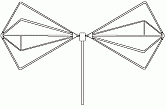
In radio systems, a biconical antenna is a broad-bandwidth antenna made of two roughly conical conductive objects, nearly touching at their points. [1]
Contents
Biconical antennas are broadband dipole antennas, typically exhibiting a bandwidth of three octaves or more. A common subtype is the bowtie antenna, essentially a flattened version of the biconical design which is often used for short-range UHF television reception. These are also sometimes referred to as butterfly antennas. [2]
Sir Oliver Lodge is the inventor of the biconical antenna. [3] [4]


